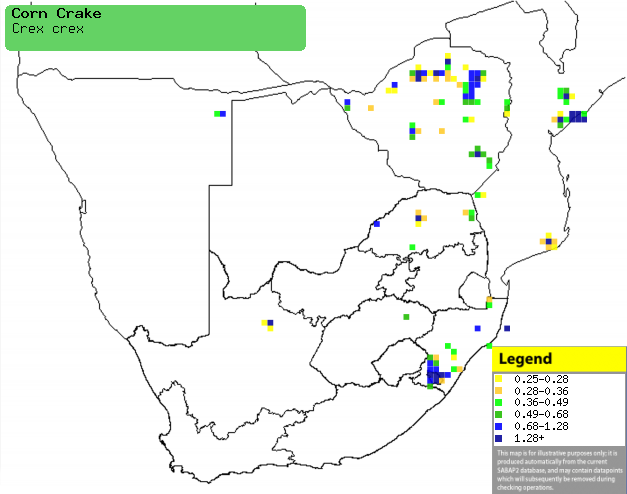|
Crex crex (Corn crake, Corncrake)
Kwartelkoning [Afrikaans]; Katukutuku (generic term for crake) [Kwangali];
Kwartelkoning [Dutch]; R‚le des genÍts [French]; WachtelkŲnig [German];
Codorniz„o-euroasiŠtico [Portuguese]
Life
> Eukaryotes >
Opisthokonta
> Metazoa (animals) >
Bilateria >
Deuterostomia > Chordata >
Craniata > Vertebrata (vertebrates) > Gnathostomata (jawed
vertebrates) > Teleostomi (teleost fish) > Osteichthyes (bony fish) > Class:
Sarcopterygii (lobe-finned
fish) > Stegocephalia (terrestrial
vertebrates) > Tetrapoda
(four-legged vertebrates) > Reptiliomorpha > Amniota >
Reptilia (reptiles) >
Romeriida > Diapsida > Archosauromorpha > Archosauria >
Dinosauria
(dinosaurs) > Saurischia > Theropoda (bipedal predatory dinosaurs) >
Coelurosauria > Maniraptora > Aves
(birds) >
Order: Gruiformes > Family: Rallidae
Distribution and habitat
Breeds from western Europe to western Siberia and China,
heading south in the non-breeding season to non-forested regions of sub-Saharan
Africa. Within southern Africa it is locally
common in Zimbabwe, central Mozambique, north-eastern South Africa as well as KwaZulu-Natal,
generally preferring moist grassland, savanna and dry
grassland adjacent to streams or marshes.
|
 |
|
Distribution of Corn crake in southern Africa,
based on statistical smoothing of the records from first SA Bird Atlas
Project (©
Animal Demography unit, University of
Cape Town; smoothing by Birgit Erni and Francesca Little). Colours range
from dark blue (most common) through to yellow (least common).
See here for the latest distribution
from the SABAP2. |
Movements and migrations
Palearctic migrant, flying at night and
arriving in southern Africa in November and December, then leaving in the period from
March-April.
Food
Mainly eats insects and plant matter, doing most of its
foraging beneath vegetation, plucking prey from the soil and from grass tufts. The following food items have been recorded
in its diet:
Threats
Globally Vulnerable, as it is hunted
by humans when passing over the Mediterranean and north Africa.
References
-
Hockey PAR, Dean WRJ and Ryan PG 2005. Roberts
- Birds of southern Africa, VIIth ed. The Trustees of the John Voelcker
Bird Book Fund, Cape Town.
|
